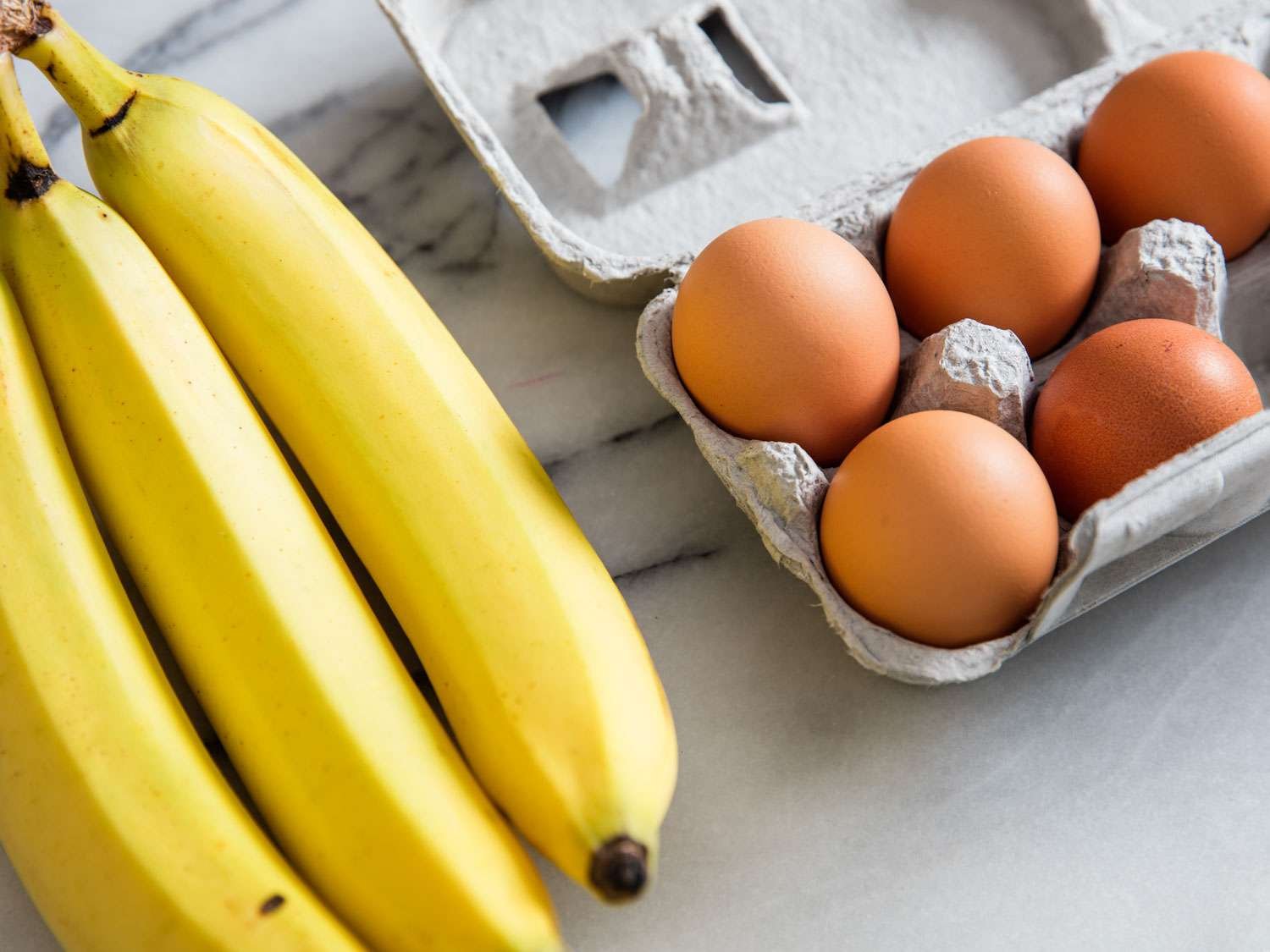:max_bytes(150000):strip_icc():format(jpeg)/__opt__aboutcom__coeus__resources__content_migration__serious_eats__seriouseats.com__images__2016__08__20160830-ripening-bananas-vicky-wasik-6-1e47924ea87740eea8580249ce0ea956.jpg)
We’ve all been there.
Hungry for a thick slice of banana bread, only to be stuck with a bunch of green bananas. In a perfect world, we’d simply pull a bag of overripe bananas from the freezer, but real-world stockpiles aren’t always so reliable. On those occasions, we’re left with few choices: hold off on banana bread, make do with greenish fruit, or fake ripeness by baking the bananas.
If you have the patience, there’s nothing wrong with option A, but I’m not wild about the alternatives. Underripe bananas have a weak flavor, while their high starch content turns quick breads chalky and dry. Prebaking may blacken their skin through oxidation and soften their pulp by breaking down its cell walls, but those bananas will need up to three hours of roasting to achieve any significant starch-to-sugar conversion. (Don’t take my word for it; just ask Harold McGee.)
Fortunately, I’ve figured out a fourth option. A simple trick that takes bananas from starchy to sweet in just 30 minutes, without any weird ingredients or major investments of time. In fact, all you need is an egg. Well, technically, just a yolk, which sounds kinda crazy, so bear with me as we dig into the backstory here.
Serious Eats / Vicky Wasik
Unripe bananas have a carbohydrate content of around 22%, which can be broken down into roughly 14% starch and 8% sugar. After harvest, bananas begin to produce ethylene gas, and several sorts of enzymes start to form. One of the enzymes breaks down chlorophyll to blacken the peel, and another breaks down pectin to soften the fruit, but the third (the one we care about) turns starch into liquid sugar: maltose and glucose.
This enzyme is known as amylase, and it’s so effective that by the time a banana turns completely black, the pulp contains no starch at all—which is why we so often find overripe bananas sitting in a pool of goo. When not making a sticky mess on your counter, that goo (glucose and maltose) gives banana bread a moist and tender crumb, along with that characteristic sweetness we love.
As previously mentioned, you can simply let nature take its course and ripen a banana over time. You can also try to speed things up by sticking the bunch in a paper bag to trap ethylene and hasten the production of amylase, but even that takes a while.
Serious Eats / Vicky Wasik
The bananas above came from the same bunch (pictured together, unripe, a few paragraphs back). The trio on the left sat out on the counter, exposed to open air, while the trio on the right were stuffed in a paper bag. After three days, they were vaguely more yellow than those left in the open air, but not by much. That’s because regardless of how much ethylene you trap, it takes some time for the bananas to synthesize amylase on their own.
Which got me thinking: Why wait? Amylase occurs naturally in egg yolks, and it’s the very thing that can reduce a beautifully thick lemon meringue pie to a weepy mess in a matter of hours. That’s why most recipes will have you cook a starch-thickened custard until it’s bubbling-hot. The eggs and starch will set up nicely at much lower temperatures, but it’s all for naught if the amylase isn’t denatured (which happens at around 170°F; a bit higher if sugar is involved).
If a few egg yolks can decimate a quart of custard, I figured they’d have no trouble breaking down a starchy banana. To put that theory to the test, I mashed some yellow-green bananas and egg yolks together, one yolk for every four ounces of fruit. Then I divided that mixture into several equal batches by weight.
Serious Eats / Vicky Wasik
Next, I grabbed a bottle of Lugol’s Iodine, a dark-orange solution of iodine and potassium iodide that turns blue-black in the presence of starch. I stirred a few drops into one portion of the banana mixture, which immediately turned a disgusting shade of ewwww.
Serious Eats / Vicky Wasik
Yup. That’s one starchy banana.
I covered the remaining portions and planned to retest every 30 minutes, but to my surprise, the very next batch showed a shocking improvement. While the pulp itself had darkened from oxidation, the iodine revealed nothing more than a few starchy patches.
Serious Eats / Vicky Wasik
The continued oxidation of the banana pulp made each subsequent test harder to visually assess, but the marked difference between the first two batches was all I needed to know that the amylase in the egg yolk was most certainly doing its thing.
Granted, that’s no help when it comes to snacking or making a banana smoothie (unless you’re open to the idea of a raw egg), but it’s a game-changer for banana bread. Whatever your recipe, just mash the required bananas and eggs together and wait at least 30 minutes, longer if your bananas are super green.
If your recipe is heavy on bananas and low on eggs, slip in an extra yolk to ensure you have enough fuel for the conversion. It’ll make the banana bread slightly more rich and moist, a win/win scenario if I ever saw one. If you’d prefer not to alter your recipe, simply give the process a little more time—about an hour for a two-egg/four-banana recipe.
Whether you’re speed-ripening bananas for my recipe or yours, happy baking!
September 2016
https://www.seriouseats.com/how-to-ripen-bananas-fast-11680756
https://www.seriouseats.com/thmb/-9cbe-z0hg8TCRY7gZZCjludwMw=/1500×0/filters:no_upscale():max_bytes(150000):strip_icc()/__opt__aboutcom__coeus__resources__content_migration__serious_eats__seriouseats.com__images__2016__08__20160830-ripening-bananas-vicky-wasik-6-1e47924ea87740eea8580249ce0ea956.jpg
Fruit Guides,Fruit Recipes,Recipes By Ingredient,Recipes,Techniques,How-Tos,Ingredient Guides,Serious Eats
#30Minute #Banana #Ripening #Hack #Knew #Sooner
Check out this PAGE – https://www.seriouseats.com/how-to-ripen-bananas-fast-11680756
Check out this Page Travel Package discount Must haves – Source2
Disclaimer: As an Amazon Associate, I earn from qualifying purchases; I may earn a commission from qualifying purchases as an affiliate. Please note that I only recommend products I believe will provide value to my readers.




